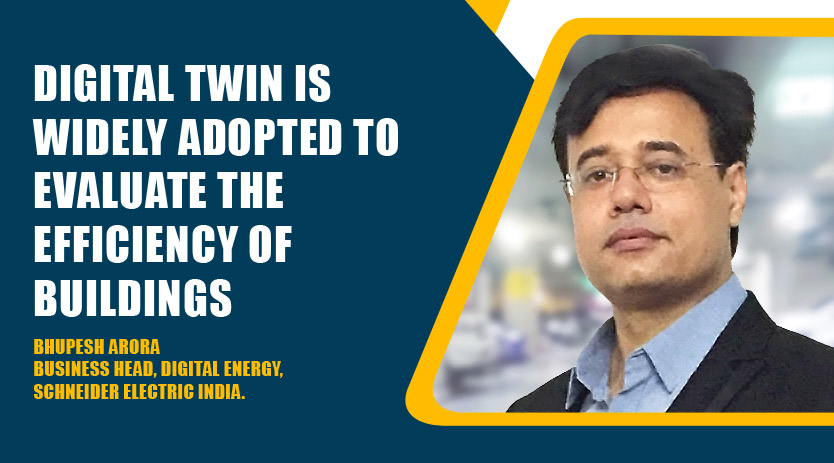EcoStruxure Building Operation 2022 platform interprets data to help drive sustainability, operational efficiency, and occupant comfort, states Bhupesh Arora, Business Head, Digital Energy, Schneider Electric India.
Emerging opportunities in the built environments in the area of thermal comfort
Today, disruptive technologies are rapidly changing the built environment in the thermal control space. And organisations are steadily tapping into enhanced efficiencies to explore new opportunities. We can see that Smart buildings are driving the need for technology adoption into built environments, wherein an intelligent application continuously collecting sensor data can be used to monitor the health of every zone of the indoor environment.
Smart thermostats or controls, such as Connected Rooms Solution, help predict occupants’ behaviour by calculating usual and preferred temperatures. This algorithm enables the adaption of the right indoor temperature based on the occupant’s daily rhythm. For example, humidity can be tracked to ensure optimal levels, as ASHRAE and the EPA recommended. Adequate air circulation across the building can be confirmed, while CO2 and VOC levels are monitored where employees gather. This data can be fed into the building management system to adjust settings. Tracking occupancy and under-desk sensor data can also ensure cleaning crews clean the right places at the right time. At the same time, VOC monitoring can indirectly confirm whether cleaning has been adequate.
AI is on the verge of rapidly changing the built environment thermal control space. With a slew of sensors deployed all over the built environments of today and tomorrow, the HVAC systems can be utilised optimally.
AI enhance BMS monitoring in HVAC systems
Next-generation building management systems (BMS) meet the needs of ever-changing customer requirements due to rapid digitalisation and create ‘Buildings of the Future by offering more connectivity, interoperability, and intelligence. They help bring different systems and devices into a control centre for building operations.
These integrated building systems:
- Leverage IoT connectivity to make valuable building data accessible, with visibility to how, where, and when energy is consumed.
- Offer advanced cloud-based analytics, including artificial intelligence (AI) and machine learning, to convert that data into actionable information accessible through any device, thanks to being designed for mobility.
- Are not closed systems. Achieving net-zero carbon goals will require more significant inputs and interoperability to help you make the right decisions and act on them. A closed system can’t deliver everything you need.
Emerging BMS monitoring and access control solutions for regulating HVAC systems
The emerging BMS monitoring tools change how building owners and their occupants communicate with each other. It opens the doors to predictive and proactive maintenance. The facility teams and service personnel have direct access to a wide range of parameters indicative of the HVAC system’s health – all on an integrated, easy-to-use dashboard. At Schneider Electric, the EcoStruxure Building Operation 2022, part of the EcoStruxure Building ecosystem, offers new levels of flexibility and scalability, helping monitor, manage, and optimise siloed systems traditionally.
- In addition to HVAC, power, lighting, security, and fire systems, the platform also integrates EV charging stations, microgrids, and renewable energy sources.
- It can integrate with various intelligent, connected devices – such as IoT-enabled room sensors – to continuously gather insights on environmental comfort and occupant well-being. • It offers API tools that enable continuous expansion of capabilities, from integrating elevators to Outlook schedules. Industry-leading cybersecurity ensures all these connections and integrations are secure.
- The platform interprets data to help drive sustainability, operational efficiency, and occupant comfort.
- Built-in tagging tools and standards make it easier to understand the data you already have and new sources you may soon need.
- And, of course, industry-leading compliance and cybersecurity features help ensure resiliency and peace of mind.
BMS presence to enhance HVAC performance
BMS can oversee smooth and reliable coordination of buildings dispersed by distance while ensuring safety and efficiency in their operation. Integrating BMS with subsystems, IoT devices, sensors, databases, and apps can not only handle but efficiently orchestrate Big Data floating around in the cloud, to effectively monitor and predict the best course of action for the connected HVAC system. From big-picture views to zooming into granular details, your facility team will get complete visibility and control over what is going on in your building today while adapting to tomorrow’s needs.
AI algorithms combined with the BMS can continually study the trends of HVAC system usage and provide energy-efficient solutions for optimal use that strike a balance between thermal comfort, emission reduction and cost.
Challenges faced by using BMS for monitoring and maintenance of HVAC.
The challenge is making building data and automation work to help achieve the ambitious goal of making Open systems talk to each other by genuinely integrating and connecting systems that exchange information and empowers facility managers to make better decisions. Another challenge lies in the flexibility of adapting and responding to owners’ and society’s needs both today and in the future and then unlocking and utilising the potential of available data.
A typical traditional building utilises BMS combined with HVAC, lighting, access control, and power monitoring. This connected system leaves the work to be A typical traditional building utilises BMS combined with HVAC, lighting, access control, and power monitoring. This connected system leaves the work to be done through highly manual and labourintensive processes, leaving building owners dependent on experienced facility managers only trained for regular and reactive maintenance to ensure the smooth running of the building. Occupants have no control or understanding of the ins and outs of the building management system, and the facilities are managed independently.
AI technology as the subsequent transformation in HVAC control in large buildings
In all digital & all electric worlds, everything connects to provide a valuable data pool to gain required operational insights. Collecting this data is critical, but what you do with that data will determine your building optimisation success.
So how do you ensure that the data is analysed to deliver these insights? The answer is taking advantage of a platform that combines best-in-class operational technology (OT) and information technology (IT) solutions. The solutions we have developed through AI, like Building Advisor – unlock the building’s performance to maintain your facilities remotely and proactively. With its key operation insights, you can reduce energy consumption and unscheduled maintenance and extend the life of your assets to save time and money. It is a cloud-based suite of analytics and monitoring services that provide critical insights into the building operations by constantly monitoring systems and identifying faults to address building inefficiencies proactively. It delivers a comprehensive view of building systems, as well as the identification of defects and inefficiencies to make data-driven decisions.
Using AI algorithms and analytics further allows you to understand the building’s energy use and help transition from a reactive operating model to a more effective preventive mindset.
Advantages of implementing AI technology in HVAC systems for building controls
AI technology is driving the digital services in buildings providing opportunities to remote everything. For digital services to be of value, they must ensure the sensor data is gathered, stored, managed, optimised, safeguarded, and monetised in the cloud and analysed by a dedicated person. Often operators do not have the required skill set to understand and use the full potential of AI capabilities. That is when access to digital experts that can monitor the buildings 24/7 comes into play. Our Connected Service Hub can be another excellent example of how to predict the building operating parameters and fully optimise them. These remote experts use their domain expertise to troubleshoot and analyse the performance of your critical and non-critical assets and building and power management systems. By working together, operators can ensure that they maximise the potential of their real estate most efficiently and sustainably. Continuous system and equipment monitoring are essential to optimise performance and realise a good investment return. With regular reports or consulting with digital experts, you can lower maintenance costs, increase reliability, and produce savings to reinvest in future growth and optimisation of the building.
AI techniques enhance the control of HVAC systems for occupant comfort. Digital Twin is being adopted widely to evaluate the efficiency of buildings. By analysing target versus actual occupancy levels, setpoints for HVAC can be adjusted where needed to reduce energy consumption. Equipment analytics can compare HVAC performance against design specifications to verify proper operation, while airflow, pressure, temperature, and humidity are monitored to maintain a healthy work environment.
Businesses need to comply with new safe distancing rules. At the same time, it’s essential to adapt space so that people can work efficiently. Digitisation can help. Occupancy sensors can track how many people are in a given area, what spaces are being used, and how. Occupancy thresholds can be set to control access to floors, rooms, or shared areas like a cafeteria. This can help avoid overcrowding and keep occupants distanced. Usage pattern data on individual and collaborative spaces can also help office, and facility managers optimise office layouts and adjust interim policies to use specific areas.
Cookie Consent
We use cookies to personalize your experience. By continuing to visit this website you agree to our Terms & Conditions, Privacy Policy and Cookie Policy.















